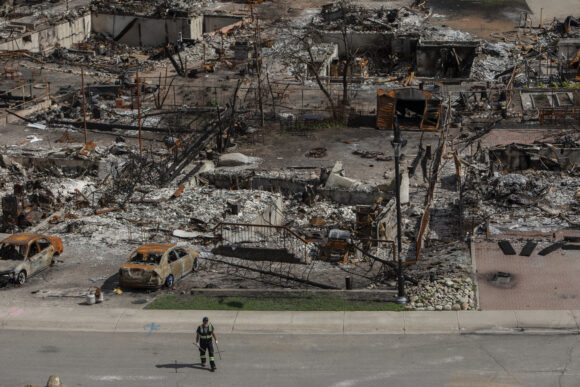As climate change fuels hotter summers, intense hailstorms, and severe flooding across Canada, the insurance sector is facing mounting pressure. The surge in natural disasters—from wildfires in popular tourist spots to major urban floods—is stretching the industry’s resources thin, leading to staff shortages and potential delays in processing claims.
Insurance adjusters play a crucial role in this ecosystem. They investigate claims to assess losses and determine insurance payouts. But with more homeowners and businesses filing claims due to extreme weather, the demand for adjusters has skyrocketed, and Canada is struggling to keep pace.
The challenge is compounded by Canada’s vast forests and varying provincial certification standards for adjusters, which hinder a rapid and unified response, according to industry insiders and consumer groups.
“The sheer volume of natural catastrophes has put enormous strain on adjusters, who are essential for ensuring timely support to affected consumers,” said the Insurance Bureau of Canada (IBC).
In Alberta’s Jasper region, for example, insurance adjusters toured the community by bus following a devastating wildfire that damaged or destroyed roughly a third of the area. This blaze is now the second-costliest wildfire in Alberta’s history, with insured losses estimated to top C$880 million (about $653.5 million).
Globally, insurers have managed rising claims from climate-driven disasters mainly by hiking premiums and excluding certain businesses. Intact Financial, Canada’s largest property and casualty insurer, reported that about 250 policyholders in Jasper suffered damage, with losses falling within its expected annual catastrophic event range of C$900 million. Intact covers around 700 families and businesses in that region.
Similarly, TD Insurance anticipates claims and related costs exceeding C$300 million in the fourth quarter, driven by recent hailstorms in Calgary and flooding in Montreal, following C$186 million in claims from Toronto floods and Alberta wildfires earlier this year.
Last year, wildfires ravaged 18.5 million hectares—over double the previous record from 20 years ago—casting an orange haze across Europe and the U.S. Canadian claims linked to extreme weather have nearly doubled over the past decade, reaching more than 1.3 million, the IBC reports.
“I used to handle just one catastrophic event annually. Now, it’s a dozen per year,” said Anita Paulic, director of operations at ClaimsPro, an independent claims management company. Paulic noted that her teams have recently juggled flood claims in Toronto, hail damage in Calgary, and wildfire losses all at once.
Over the last decade, insured losses from natural disasters have averaged C$2.2 billion annually—more than triple the previous decade’s average. The IBC expects these escalating costs to continue.
Adjusters often serve as mediators between consumers and insurers, but the surge in claims has slowed settlements. Restricted access to disaster zones further complicates their work.
Kyler Hart-Moore, an executive general adjuster at Alberta-based Laurin Adjusters, described the workload as relentless: “You’re barely getting a handle on one disaster when another one hits immediately after.”
He likened the job to “drop your fork service”—meaning adjusters must respond immediately, regardless of what else they are doing.
Peak Season and Staffing Challenges
The wildfire season, particularly between June and August, marks the busiest time for claims adjusters. This year, over 4,800 wildfires swept through Canada, the world’s third most forested country. These fires displaced thousands and disrupted industries like oil and mining in remote areas.
Meanwhile, many Canadian adjusters are approaching retirement, and because licensing is provincial, it’s challenging for adjusters to shift between regions as demand fluctuates.
Industry experts say Canada will need 10% to 20% more adjusters within the next five years to keep up with growing claims. Companies like ClaimsPro are actively recruiting younger professionals at college job fairs, targeting those willing to travel for assignments.
However, the job’s emotional demands—working with people who have lost homes and livelihoods—mean it’s not suited for everyone.
“The balance of empathy without slipping into sympathy is crucial and very challenging,” Hart-Moore explained.


This article really highlights the growing challenges our insurance industry faces with climate change. It’s eye-opening to see how much the workload for adjusters has increased and the emotional toll it takes. Thanks for sharing!
I wasn’t aware that wildfires alone could cause such massive insured losses in Canada. It’s clear that climate change is impacting many sectors, including insurance. Hopefully, more people will become aware and prepare accordingly.
Great coverage of an important issue. The shortage of adjusters and the regional licensing hurdles are surprising challenges. I hope the industry can find solutions quickly to support those affected by these disasters.
This is exactly what climate scientists have been warning about. The insurance industry is just one of many sectors starting to feel the real economic pressure of climate change.
I think insurers are using climate change as an excuse to raise premiums. Many of these companies have made record profits in recent years.
There’s definitely a growing risk, but I think it’s also about how unprepared the industry was. They need better modeling and response strategies.